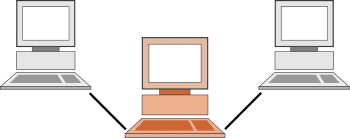(
ATM) is a standardized digital data transmission technology. ATM is implemented as a
network protocol and was first developed in the mid 1980s.
[1] The goal was to design a single networking strategy that could transport real-time video conference and audio as well as image files, text and email.
[2] The
International Telecommunications Union,
American National Standards Institute,
European Telecommunications Standards Institute,
ATM Forum,
Internet Engineering Task Force,
Frame Relay Forum and
SMDS Interest Group were involved in the creation of the standard.
[3] Asynchronous Transfer Mode is a cell-based switching technique that uses asynchronous time division multiplexing.[4][5] It encodes data into small fixed-sized cells (cell relay) and provides data link layer services that run over OSI Layer 1 physical links. This differs from other technologies based on packet-switched networks (such as the Internet Protocol or Ethernet), in which variable sized packets (known as frames when referencing Layer 2) are used. ATM exposes properties from both circuit switched and small packet switched networking, making it suitable for wide area data networking as well as real-time media transport.[6] ATM uses a connection-oriented model and establishes a virtual circuit between two endpoints before the actual data exchange begins.[7]
ATM is a core protocol used over the SONET/SDH backbone of the Integrated Services Digital Network.
ATM has proven very successful in the WAN scenario and numerous telecommunication providers have implemented ATM in their wide-area network cores. Many ADSL implementations also use ATM. However, ATM has failed to gain wide use as a LAN technology, and lack of development has held back its full deployment as the single integrating network technology in the way that its inventors originally intended. Since there will always be both brand-new and obsolescent link-layer technologies, particularly in the LAN area, not all of them will fit neatly into the synchronous optical networking model for which ATM was designed. Therefore, a protocol is needed to provide a unifying layer over both ATM and non-ATM link layers, as ATM itself cannot fill that role. IP already does that; therefore, there is often no point in implementing ATM at the network layer.
In addition, the need for cells to reduce jitter has declined as transport speeds increased (see below), and improvements in Voice over IP (VoIP) have made the integration of speech and data possible at the IP layer, again removing the incentive for ubiquitous deployment of ATM. Most Telcos now[update] plan to integrate their voice network activities into their IP networks, rather than their IP networks into the voice infrastructure.
MPLS, a generic Layer 2 packet-switching protocol, adopted many technically sound ideas from ATM. ATM remains widely deployed, and is used as a multiplexing service in DSL networks, where its compromises fit DSL's low-data-rate needs well. In turn, DSL networks support IP (and IP services such as VoIP) via PPP over ATM and Ethernet over ATM (RFC 2684).
ATM will remain deployed for some time[update] in higher-speed interconnects where carriers have already committed themselves to existing ATM deployments; ATM is used here as a way of unifying PDH/SDH traffic and packet-switched traffic under a single infrastructure.
It is often claimed that "ATM is increasingly challenged by speed and traffic shaping requirements of converged networks. In particular, the complexity of Segmentation and Reassembly (SAR) imposes a performance bottleneck, as the fastest SARs known run at 10 Gbit/s". However with ATM interfaces available at up to STM-16 (2.5Gbps - such as the Cisco SPA-1XOC48-ATM for their 7600 series routers) and even STM-64 (10Gbps for example the Cisco MGX 8950 OC-192c/STM-64) ATM can still readily challenge even 10GE interfaces for speed and typically exceed the ability of other protocols in terms of Quality of Service - especially on busy links.
As far as SAR issues are concerned, since SAR is carried out at the edge of an ATM network, this is not a core switching issue but rather a task left to the edge devices (or the applications themselves) and currently (as at 2009) it would be true to say that any single interface on a Router is struggling to exceed 10Gbps throughput and this 10Gbps limitation is not limited to merely ATM SAR but also the switching and routing capabilities of Router interfaces in general.
Currently, it seems likely that gigabit Ethernet implementations (10Gbit-Ethernet, Metro Ethernet) will replace ATM as a technology of choice in new WAN implementations.
Interest in using native ATM for carrying live video and audio has increased recently[update]. In these environments, low latency and very high quality of service are required to handle linear audio and video streams. Towards this goal standards are being developed such as AES47 (IEC 62365), which provides a standard for professional uncompressed audio transport over ATM. This is worth comparing with professional video over IP.








